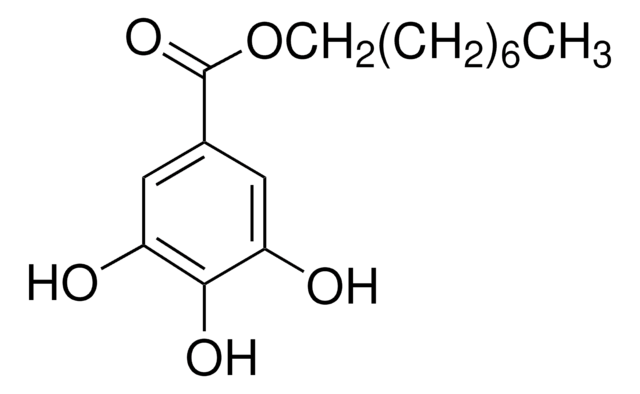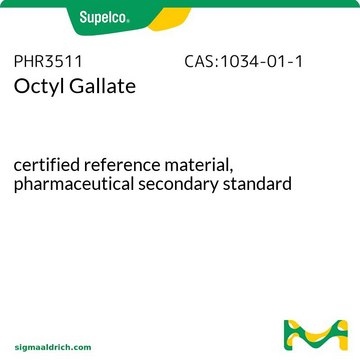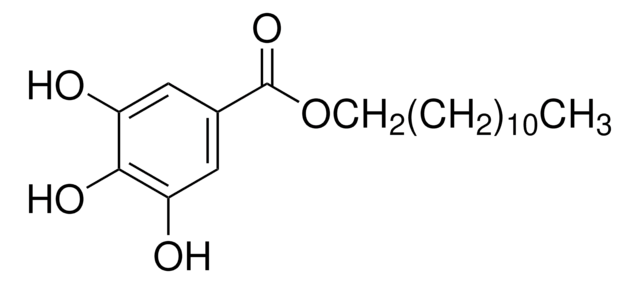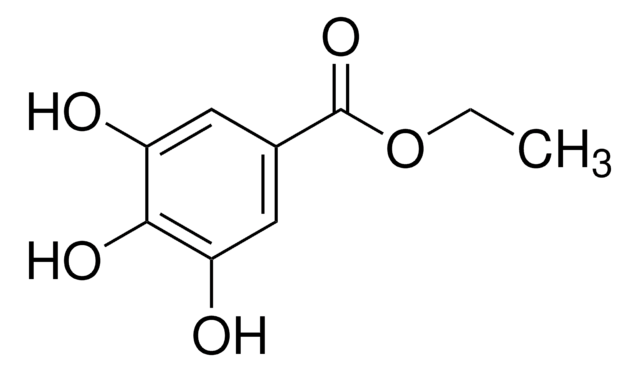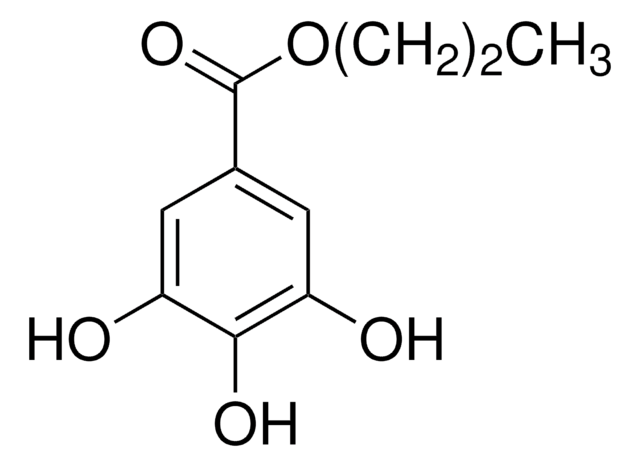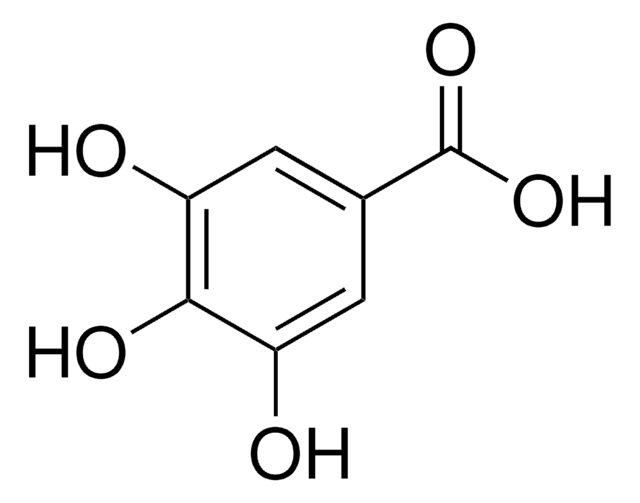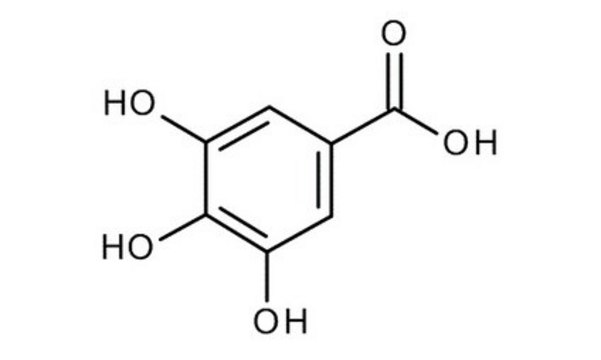48660
Lauryl gallate
antioxidant, ≥99.0% (HPLC)
Synonym(s):
Dodecyl gallate
Sign Into View Organizational & Contract Pricing
All Photos(1)
About This Item
Empirical Formula (Hill Notation):
C19H30O5
CAS Number:
Molecular Weight:
338.44
Beilstein:
2701981
EC Number:
MDL number:
UNSPSC Code:
12352100
PubChem Substance ID:
NACRES:
NA.22
Recommended Products
Quality Level
Assay
≥99.0% (HPLC)
form
solid
mp
94-97 °C (lit.)
functional group
ester
SMILES string
CCCCCCCCCCCCOC(=O)c1cc(O)c(O)c(O)c1
InChI
1S/C19H30O5/c1-2-3-4-5-6-7-8-9-10-11-12-24-19(23)15-13-16(20)18(22)17(21)14-15/h13-14,20-22H,2-12H2,1H3
InChI key
RPWFJAMTCNSJKK-UHFFFAOYSA-N
Looking for similar products? Visit Product Comparison Guide
Application
- Properties of artificial phospholipid membranes containing lauryl gallate or cholesterol: This study explores how lauryl gallate affects membrane structure, impacting its biological functions (Jurak et al., 2018).
- Potential of Lauryl Gallate as Stability and Recyclability Improver of Poly (Butylene succinate-co-adipate): Lauryl gallate enhances the stability and recyclability of polyesters, important for sustainable materials (Rossi et al., 2024).
- Lauryl Gallate Activity and Streptococcus mutans: The study evaluates the antibacterial effects of lauryl gallate against Streptococcus mutans, showing significant biofilm reduction and gene expression impact (Gabe et al., 2020).
- Dodecyl gallate as a pro-ecological antioxidant for food packing materials: This research investigates the use of lauryl gallate as a green antioxidant, enhancing the age-resistance of food packaging (Masek et al., 2014).
Signal Word
Warning
Hazard Statements
Precautionary Statements
Hazard Classifications
Skin Sens. 1
Storage Class Code
11 - Combustible Solids
WGK
WGK 1
Flash Point(F)
Not applicable
Flash Point(C)
Not applicable
Personal Protective Equipment
dust mask type N95 (US), Eyeshields, Gloves
Choose from one of the most recent versions:
Already Own This Product?
Find documentation for the products that you have recently purchased in the Document Library.
Annarica Calcabrini et al.
Carcinogenesis, 27(8), 1699-1712 (2006-04-21)
Lauryl gallate is an antioxidant food additive showing low toxicity to normal cells. Here, its antiproliferative effect has been studied on three human breast cancer cell lines: estrogen-dependent, wild-type p53, MCF7; estrogen-independent, non-functional p53, MDA-MB-231 and MCF7 ADR, which overexpresses
Isao Kubo et al.
Bioorganic & medicinal chemistry letters, 12(2), 113-116 (2002-01-05)
A series of alkyl gallates (3,4,5-trihydroxybenzoates) was found to show antibacterial activity against Gram-positive bacteria including methicillin resistant Staphylococcus aureus (MRSA) strains. For example, dodecyl (C(12)) gallate (1) exhibited bactericidal activity against MRSA ATCC 33591 strain with the minimum bactericidal
Isao Kubo et al.
Bioorganic & medicinal chemistry, 11(4), 573-580 (2003-01-23)
Dodecyl (C(12)) gallate (3,4,5-trihydroxybenzoate) (1) was found to possess antibacterial activity specifically against Gram-positive bacteria, in addition to its potent antioxidant activity. The time-kill curve study indicates that this amphipathic gallate exhibits bactericidal activity against methicillin resistant Staphylococcus aureus (MRSA)
Isao Kubo et al.
Journal of agricultural and food chemistry, 50(12), 3533-3539 (2002-05-30)
Dodecyl (C12) gallate exhibits both potent chain-breaking and preventive antioxidant activity. The pyrogallol moiety is responsible for both activities. Dodecyl (lauryl) gallate prevents generation of superoxide radicals by xanthine oxidase, and this activity comes from its ability to inhibit the
K Fujita et al.
Journal of applied microbiology, 92(6), 1035-1042 (2002-05-16)
The aim was to investigate the antifungal actions of nonyl gallate against Saccharomyces cerevisiae ATCC 7754. The maximum potency of both the growth inhibitory and the fungicidal effect against the yeast strain was found in nonyl gallate among n-alkyl gallates
Our team of scientists has experience in all areas of research including Life Science, Material Science, Chemical Synthesis, Chromatography, Analytical and many others.
Contact Technical Service